
Andalusia is the southernmost autonomous community in Peninsular Spain. Andalusia is located in the south of the Iberian Peninsula, in southwestern Europe. It is the most populous and the second-largest autonomous community in the country. It is officially recognised as a historical nationality and a national reality. The territory is divided into eight provinces: Almería, Cádiz, Córdoba, Granada, Huelva, Jaén, Málaga, and Seville. Its capital city is Seville. The seat of the High Court of Justice of Andalusia is located in the city of Granada.

Huelva is a municipality of Spain and the capital of the province of Huelva, in the autonomous community of Andalusia. Located in the southwest of the Iberian Peninsula, it sits between the estuaries of the Odiel and Tinto rivers on the Atlantic coast of the Gulf of Cádiz. According to the 2010 census, the city had a population of 149,410.

Alosno is a town and municipality located in the province of Huelva, Spain. According to the 2013 census, the village has a population of 1,840 inhabitants. The Filon Sur Mine, in Alosno municipality, is a notable source of fine specimens of the mineral goethite. Nearby is a 4500+ year old copper smelting archeological site named Cabezo Juré.

The Andalusians are the people of Andalusia, an autonomous community in southern Spain. Andalusia's statute of autonomy defines Andalusians as the Spanish citizens who reside in any of the municipalities of Andalusia, as well as those Spaniards who reside abroad and had their last Spanish residence in Andalusia, and their descendants. Since reform in 2007, the Andalusian statute of autonomy identifies the territory as a historic nationality in the preamble. The Spanish Language Academy recognizes Andalusian Spanish as a set of diverse dialects. Andalusian nationalism is the belief that Andalusians are a nation separate from other ethnicities within Spain.

Benahadux is a municipality of Almería province, in the autonomous community of Andalusia, Spain.
Enix is a municipality of Almería province, in the autonomous community of Andalusia, Spain.
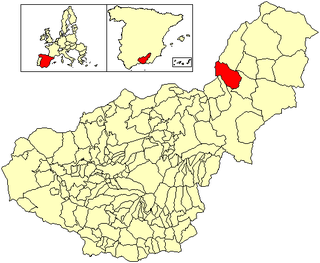
Cortes de Baza is a municipality located in the province of Granada, Spain. According to the Instituto de Estadistica y Cartografia de Andalucia (2020), the village has a population of 1844 inhabitants.

Estepa is a municipality in the extreme south-east of the province of Seville. It had a population of 12.631 in 2013. The town is located north of the Sierra del Becerro mountains.
The Technological Corporation of Andalusia in the autonomous community of Andalusia, Spain is the largest public-private partnership in Spain linking scientific and industrial innovation. The project was presented publicly 27 July 2005, and the official act constituting it was put into effect 10 October 2005. As of 2010 its president is Joaquín Moya-Angeler Cabrera.
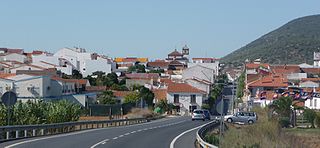
Rosal de la Frontera is a municipality of Spain located in the province of Huelva, Andalusia. According to the 2008 census, the municipality had a population of 1846 inhabitants.
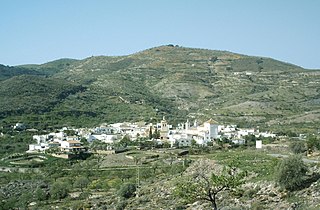
Turón is a municipality in the province of Granada, Spain. As of 2010, it has a population of 297 inhabitants.

The second government of Susana Díaz was formed on 18 June 2015 following the latter's reelection as President of Andalusia by the Parliament of Andalusia on 11 June and her swearing-in on 14 June, as a result of the Socialist Party of Andalusia (PSOE-A) emerging as the largest parliamentary force at the 2015 Andalusian regional election. It succeeded the first Díaz government and was the Government of Andalusia from 18 June 2015 to 22 January 2019, a total of 1,314 days, or 3 years, 7 months and 4 days.

The first government of Juan Manuel Moreno was formed on 22 January 2019, following the latter's election as President of the Regional Government of Andalusia by the Parliament of Andalusia on 16 January and his swearing-in on 18 January, as a result of the People's Party (PP) and Citizens (Cs) being able to muster a majority of seats in the Parliament with external support from Vox following the 2018 Andalusian regional election. It succeeded the second Díaz government and was the Regional Government of Andalusia from 22 January 2019 to 26 July 2022, a total of 1,281 days, or 3 years, 6 months and 4 days.

Lina Gálvez Muñoz is a Spanish economic historian and politician, and member of the European Parliament since 2019. She was Minister of Knowledge, Research and University of the Regional Government of Andalusia from 2018 to 2019. She is an expert in feminist economics and member of Economists Without Borders.
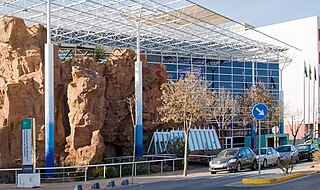
Instituto de Estadística y Cartografía de Andalucía (IECA) is a public organization which coordinates and announces statistics and cartography in Andalucía. In 2019 it was named Elena Manzanera Díaz as the directress.
La Zarza-Perrunal, known until 1991 as Silos de Calañas and Minas de Perrunal, is a municipality located in the Province of Huelva, in the autonomous community of Andalusia, Spain, which includes the localities of La Zarza and Perrunal, since their separation in 2018. Before then, it belonged to the municipality of Calañas. The municipality is part of the Andévalo comarca although it is located at the foot of the Sierra de Aracena.
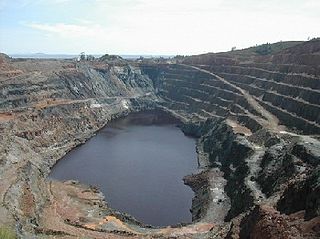
The Tharsis-La Zarza mining basin, colloquially known as the Tharsis mines, is a Spanish mining area located in the province of Huelva. Its main centers are in the municipalities of Alosno, Calañas, Cerro de Andévalo and La Zarza-Perrunal. The basin is part of the Iberian Pyrite Belt.
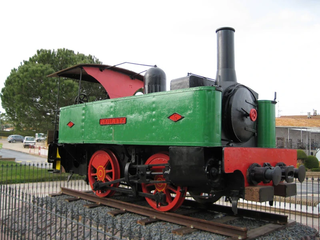
The Tharsis railway line, also known as the Tharsis-Río Odiel railway, was a Spanish narrow-gauge railway of mining industrial nature that operated between 1871 and 2000. It served as one of the most important railroads in the province of Huelva.
The Compañía Española de Minas de Tharsis was a Spanish company belonging to the mining sector, whose activity was developed mainly in the Tharsis-La Zarza mining basin. It was born as heir to the former British company that had operated the Tharsis mines since the mid-19th century. The company was active between 1978 and 1995, ceasing operations due to the crisis that the sector was going through at that time.

The Gibraleón-Ayamonte line, also known as the Huelva-Ayamonte line, was a 49-kilometer-long Iberian gauge Spanish railway line that came to operate in the province of Huelva. The line was in operation between 1936 and 1987, covering the western coast of Huelva.





















